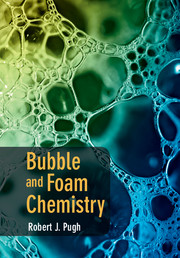Book contents
- Frontmatter
- Contents
- Preface
- Acknowledgments
- List of symbols
- 1 Basic principles and concepts
- 2 The nature and properties of foaming surfactants
- 3 Soap bubbles and thin films
- 4 Processes in foaming
- 5 Generation of bubbles and foams
- 6 Coalescence of bubbles in surfactant solutions
- 7 The stability/instability of bubbles and foams
- 8 Particle-stabilized foams
- 9 Foaming in non-aqueous liquids
- 10 Antifoaming and defoaming
- 11 Bubble size measurements and foam test methods
- 12 Bubble and foam chemistry - new areas of foam research
- Index
- References
7 - The stability/instability of bubbles and foams
Published online by Cambridge University Press: 05 September 2016
- Frontmatter
- Contents
- Preface
- Acknowledgments
- List of symbols
- 1 Basic principles and concepts
- 2 The nature and properties of foaming surfactants
- 3 Soap bubbles and thin films
- 4 Processes in foaming
- 5 Generation of bubbles and foams
- 6 Coalescence of bubbles in surfactant solutions
- 7 The stability/instability of bubbles and foams
- 8 Particle-stabilized foams
- 9 Foaming in non-aqueous liquids
- 10 Antifoaming and defoaming
- 11 Bubble size measurements and foam test methods
- 12 Bubble and foam chemistry - new areas of foam research
- Index
- References
Summary
The paradox is easily explained. Profit-seeking people will take more financial risk when they believe the coast is clear. By taking bigger chances, however, they unwittingly make the world unsafe all over again.
Hyman Minsky, US Economist, Paying the Price for the Fed's Success, The New York Times, www.nytimes.com/200801/27/opinion/27grant.htmlOverview
All foams are thermodynamically unstable due to their high interfacial free energy, the decrease of which causes foam decay. It is well known that there are several different types of mechanisms involved in the stabilization and decay of foams, which has caused a considerable amount of confusion. In the literature there are many conflicting explanations frequently caused by experimental anomalies and the incomplete interpretation of foaming experiments. Another aspect to consider is that the lifetime of a foam can pass through several different stages, and each stage may involve a different type of mechanism. To explain the overall stability in terms of one mechanism is almost impossible, and the interplay of different mechanisms needs to be taken into consideration. During generation, bubbles expand and contract and are subjected to severe vibrations and dynamic disturbances causing distortion of the adsorption layer. During this process, the liquid films separating the bubbles are relatively thick and subject to stretching, and viscous elastic forces play a crucial role. Possibly the most important mechanisms for the survival of a wet foam during this stage involves the surface elasticity theories of Gibbs and Marangoni. Gravitational forces also cause fairly rapid drainage to occur during this preliminary stage, but this can be retarded by a high bulk viscosity. On entering a secondary stage, capillary forces come into play causing suction and thinning of the lamellae, and this occurs at a lower rate. In addition, disproportionation may occur causing the diffusion of gas between bubbles. As all these processes occur under dynamic conditions, the equilibrium adsorption coverage is rarely reached.
The process of gas diffusion owes its origins to the difference in pressure, surface tension and curvature of the bubbles, but the gas diffusion to the atmosphere also needs to be considered. In addition to diffusive disproportionation theories to explain the changes in size distribution in bubbles, alternate processes have been considered which involve the effect of interfacial rheology on the shrinkage of bubbles.
- Type
- Chapter
- Information
- Bubble and Foam Chemistry , pp. 220 - 268Publisher: Cambridge University PressPrint publication year: 2016
References
- 3
- Cited by



